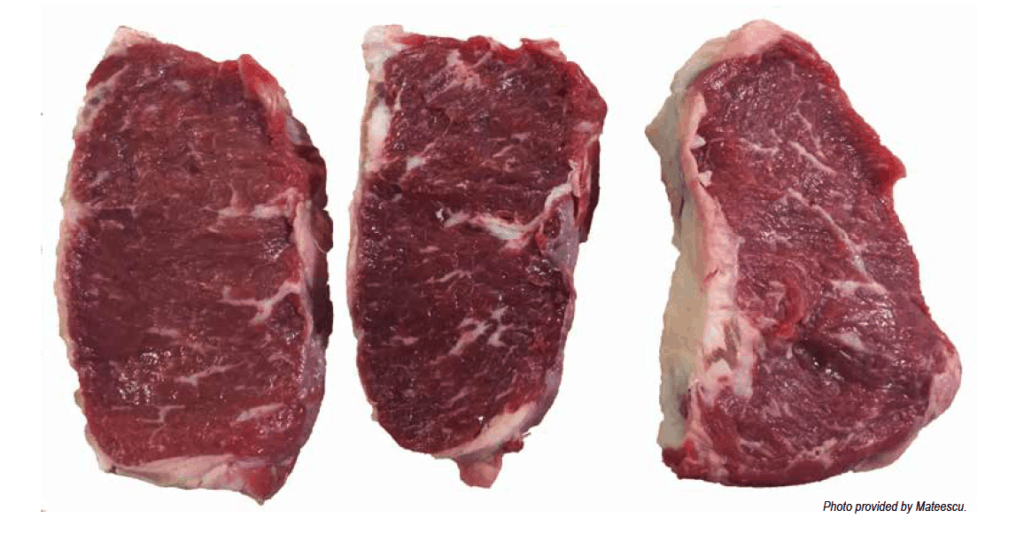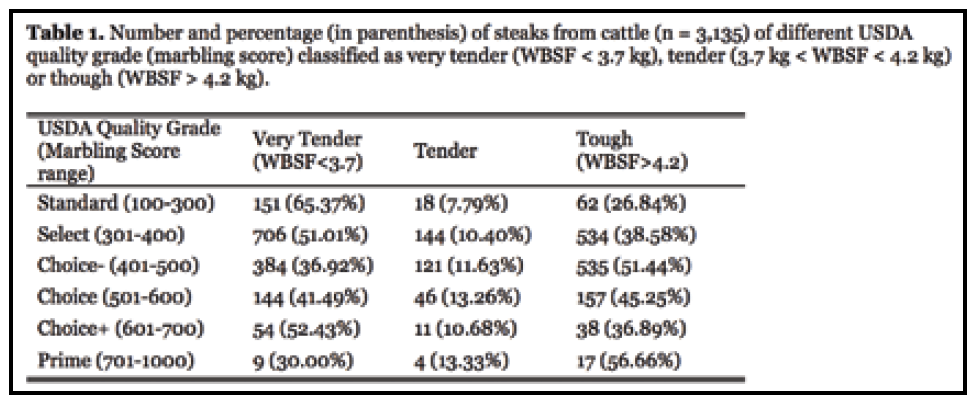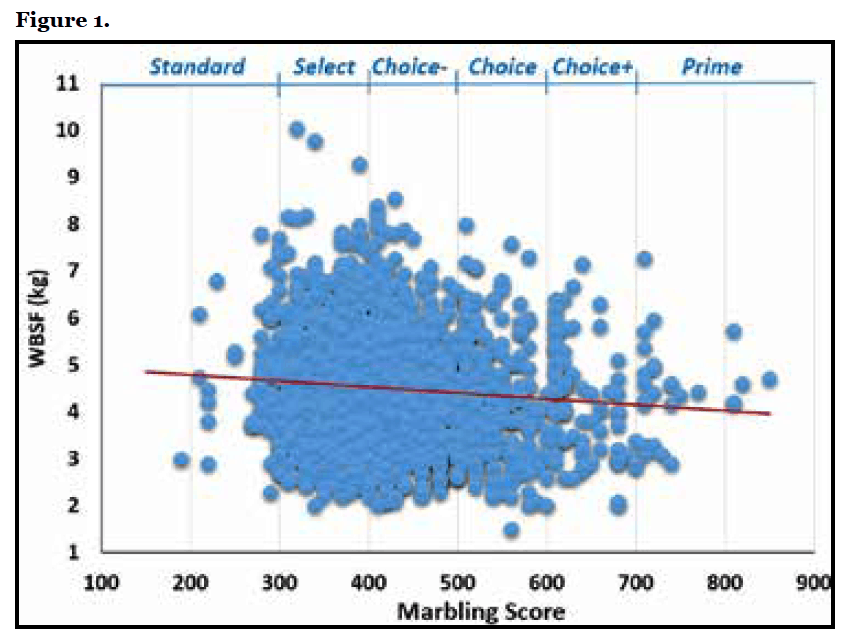Carcass Merit and Meat Quality In Bos Indicus Influenced Cattle
by Raluca Mateescu, PhD., University of Florida
The U.S. Beef Quality Audit identified low and inconsistent quality as major impediments to improving domestic demand for beef products. Consumers evaluate the quality of beef at the point of purchase with respect to freshness, marbling and color. Consumers evaluate the quality of beef at the point of consumption, where the focus is on quality of eating experience or palatability described by three sensory traits: tenderness, juiciness and flavor. Ability to deliver a consistently superior quality product is important if the beef industry is to maintain and expand its share of the market. The strength shown by the high-quality branded-beef market in the last few years confirms that a sizable proportion of consumers are willing to pay for assured quality, indicating that the importance of quality is only going to increase going forward. Meeting and exceeding quality expectations will be needed to maintain or even increase market share. Even more important for the future of the industry is expanding the consumer base. As the average income increases, new consumers will enter the beef market, and the eating quality these new consumers experience will largely determine if they will continue to demand beef. Improving eating quality is critical to convince both habitual and new consumers of the superior value they are getting from the money spent on beef. Tenderness is the most important sensory attribute consumers use to judge beef quality and is a major focus in my research program at the University of Florida.
The USDA grading system, established in 1996, is based on marbling and maturity and is used to separate beef carcasses into groups with uniform quality. In the absence of any other system, the beef industry is using the USDA grading system to determine premium and discounts, to predict the palatability of the meat from a beef carcass, and to communicate it to the consumers. Although the USDA grading system has served the industry well, changes in consumers’ preferences, limitations in the ability of the system to predict eating quality, and limited consumer understanding of how the system works are some of the problems associated with using this system as indicator of palatability. By comparison, beef is an expensive animal protein and what sets it apart are its distinctive sensory attributes leading to a unique eating experience. Programs to improve eating experience when consuming beef and the ability to better predict the eating quality level for marketing purposes are critical to increase consumers’ confidence that quality expectations are met. Management and genetic programs designed to address these issues and management practices that positively or negatively influence eating experience need to be developed.
To analyze the relationship between the USDA quality grade and the degree of tenderness, I used a dataset of 3,125 animals spanning the range from 100-percent Angus to 100-percent Brahman. In this data set, 1,378 were Brangus® animals. The phenotypes of interest were tenderness assessed by Warner-Bratzler shear force (WBSF) and USDA quality grade. The WBSF is an objective measure of tenderness, and it measures the force required to shear a cooked steak in kilograms (kg). The lower the number, the less force is required – indicating a more tender steak. The USDA-Agricultural Marketing Service (USDA-AMS) is engaged in designing standards to indicate the degree of tenderness for beef. In this program, a steak with a WBSF less than 4.2 kg is considered tender, and a steak with WBSF less than 3.7 kg is considered very tender. The average WBSF for the population used in this study was 4.49 kg and, using the USDA-AMS standard, 42.8 percent of our animals would be considered tough, 11 percent tender, and 46.2 percent would qualify as very tender.
Based on USDA grading system, cattle in our data were classified as 7.4 percent Standard, 44.1 percent Select, 33.1 percent Choice-, 11 percent Choice, 3.3 percent Choice+ and 1.1 percent Prime. Table 1 shows the tenderness classification of steaks from different quality grades based on the WBSF measurement. For example, 65.37 percent of the cattle graded Standard were graded as very tender, 7.79 percent as tender and 26.84 percent as tough, based on the WBSF. The scatterplot in Figure 1 shows the distribution of our cattle across these quality grades and their respective toughness or tenderness measured by WBSF. There are three important points to take from this figure:
There is considerable variation in the degree of tenderness across all quality grades. There is a small trend in the average tenderness across quality grades, described by the red line, indicating that, on average, steaks from higher quality grades tend to be more tender, or have lower WBSF. However, it is also clear that, most of the variability in tenderness is within quality grades and not between grades. The tenderness of steaks from carcasses graded Select or Choice, which was the majority of our animals, varied from very tender to very tough. This highlights the limitation of the USDA grading system to predict eating quality or tenderness.
On the right side of the graph, for steaks graded higher as Choice or Choice+, about 43 percent are in fact tough, based on WBSF. Consumers buying these steaks are paying a premium, and they expect a high-quality product, but 43 percent of the time, they will end up with a tough steak and, therefore, a less-than-desirable eating experience. This, in the long run, will translate into decreased beef demand, negatively impacting all sectors of the beef industry.
On the left side of the graph, 63 percent of the steaks from carcasses graded Standard or Select are in fact tender or very tender. Consumers buying these steaks are paying a lower price, purchasing a very tender steak that will provide a very positive eating experience. This is great for the consumer and will help increase beef demand, but this is an opportunity loss for the producers as they are selling a high-quality product for a lower, or even discounted, price.
Although no errors are desirable, from the consumer and marketing point of view, errors may have different consequences. We could speculate that misclassification errors for moderately tender group have relatively small market consequences, because if the price of the product reflects eating quality, as it would with a “certified tender” program, the consumer is paying and expecting average eating quality and this expectation is most likely met. On the other hand, misclassifications of a product with “tough” or “tender” quality may have a greater negative impact on consumers. Again, if we assume the eating quality is positively associated with the price of the product, not meeting quality expectations leads to dissatisfied consumers. This could have important consequences as past experience is a critical factor regarding attitude toward food. A report (SMART, 1994) evaluating the factors contributing to the intent of consumers to repurchase a product concluded that eating quality was the most important factor at 65 percent, followed by price at 28 percent. Unfulfilled eating quality expectations lead to consumers’ dissatisfaction, reduced future beef purchases and lower demand. The negative consequences associated with misclassifications of carcasses with “tender” into “moderately tender” or “tough” groups are of different nature. These errors represent opportunity losses for the industry, as the product is undervalued.
Programs to improve eating experience when consuming beef and the ability to better predict the eating quality level for marketing purposes are critical to increase consumers’ confidence and, subsequently, improve the economic position of the beef industry through increased demand for beef products.
All the components defining eating quality are quantitative traits, controlled by many genes and impacted by environmental factors. These traits are not available until late in life or after the animal has been harvested, and measuring them is difficult and expensive. Improving these traits through traditional phenotypic selection is impractical. Genomic selection using genetic markers that account for a worthwhile proportion of variation to improve provide a viable alternative. Warner-Bratzler Shear Force and the intramuscular fat content (IMFC) were identified from an extensive set of carcass and meat composition traits to be the best predictors of eating quality (Mateescu et al., 2016). Those indicator traits are difficult to measure on live animals. An important objective of our research is to develop DNA tests that can accurately identify cattle with superior genetics for WBSF and IMFC to be used by the industry to address these issues. Knowledge of the genetics controlling these traits along with a precise understanding of the biological networks and interactions underlying the meat quality complex will increase the ability of the industry respond to consumer expectations.





